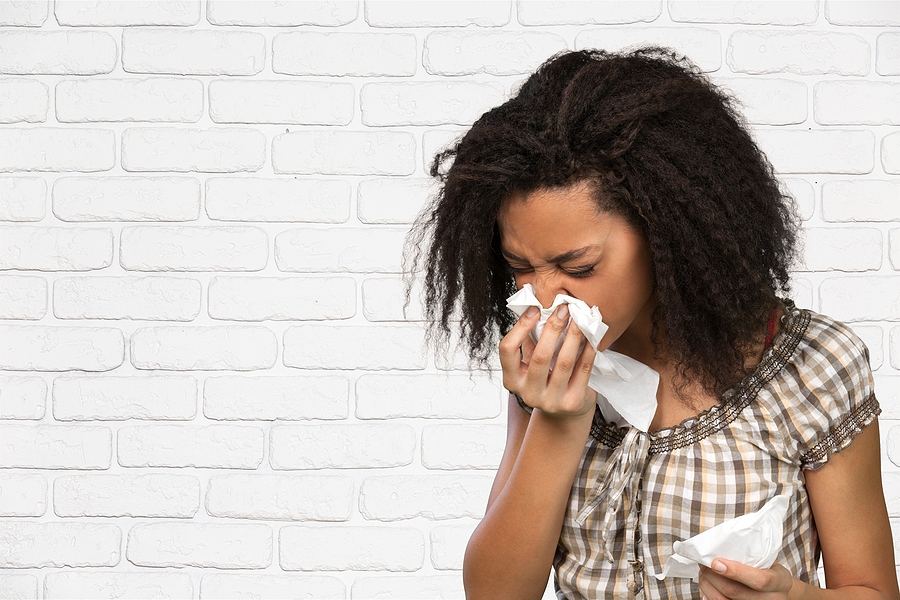Updated 04/11/2021
So often, patients arrive in my office with signs of inflammation resulting from some type of allergy that they didn’t even realize they had. It can be hard to convince these women that the pain, swelling, fatigue and other uncomfortable symptoms might be due to food they’ve been eating their whole life, the clothes they’re wearing, or the products they choose to use.
But it’s worth the time it takes to explore these possibilities thoroughly. I’ve seen some simple changes in lifestyle choices make a big enough difference for enough women that I take the time to educate my clients about the mild sensitivities or moderate allergies that could be the missing link.
Severe allergies are typically easier to identify, and they’re becoming far more common than they used to be! In fact, it’s fairly likely that at least one person you are close to has an allergy or sensitivity to something that significantly impacts their life.
In the past few decades, there’s been a sharp incline in the number of people who suffer from acute, clinical or subclinical allergies. In fact, some estimates say that over 60 million Americans now suffer from allergies, and millions more from sensitivities.
The conventional approach to allergy relief
Sadly, conventional medicine doesn’t dig into why allergies and sensitivities have increased so dramatically. Instead, conventional diagnostics treat each allergy as an isolated issue. Women with chronic allergies are often put on drugs for years, and while symptoms may subside, their overall condition rarely improves.
And the tens of millions with subclinical allergies and sensitivities are regularly misdiagnosed (even given antidepressants!) or dismissed by their doctors because their symptoms seem mysterious and unconnected.
The reality is that allergies and sensitivities almost never occur in isolation. They are usually accompanied by other health conditions and symptoms, typically appear as part of a broad pattern, and can be readily diagnosed by a skilled practitioner. The “secret” to diagnosing these patterns is this: you have to look for them!
This is a very gratifying area of practice for me because my patients see such dramatic, lasting improvement in their allergies and sensitivities — without drugs — through an integrative approach to diagnosis and treatment.
Let’s talk about how symptoms of allergies and sensitivities arise and their links to other health conditions. I think you’ll be surprised, and perhaps inspired, by how easy it is to address, once you know the actual problem.
So what is an allergy, anyway?
An allergy is an overreaction of the immune system, the body’s natural defense system. In short, the body responds as though it’s under attack, releasing antibodies and triggering inflammation, even though the stimulus of the attack (the allergen) is normally harmless.
There are three broad categories of allergic responses:
- Acute allergic reactions, which may occur rarely or in response to a single allergen (such as peanuts) and can be quite dangerous. One of my patients broke out in hives after a routine leg wax — it never happened before or thereafter, but was how she discovered she was pregnant!
- Chronic allergic reactions, which show up in the form of regular symptoms. These may be in response to a specific allergen, sometimes on a seasonal cycle when certain plants are in bloom, or in response to environmental factors such as dust mites. They may also be a result of an overload of allergens (e.g., women with chemical sensitivities).
- Subclinical allergic reactions are the trickiest to diagnose since women may suffer transient, seemingly disconnected symptoms that can be difficult to recognize as an allergic response. Comprehensive testing may be the only way to tease out the culprits in this case.
The allergic response engages the body’s inflammatory cascade, and that’s one reason it has such serious health effects. Allergic reactions are recognized as one of the most significant causes of illness and disease in America.
Allergies and sensitivities are at the root of many health problems, including respiratory ailments, skin conditions, mood disorders, and gastrointestinal symptoms. And the negative health effects resulting from the mechanism of inflammation can be profound. For more on this, see my other articles on inflammation.
Neither a chronic nor an acute allergic response is something you should ignore.
Type I allergies and anaphylactic shock
If a certain substance in your diet or environment consistently triggers an acute, measurable immune response, you have what is known as a type I, or immediate-response allergy. Type I allergic responses are what most people (and doctors) refer to when they talk about allergies.
Elevated levels of antibodies called IgE’s in the bloodstream trigger a histamine reaction: itchy watery eyes, runny nose, hives, itchy rash, swelling, scratchy throat, wheezing and coughing. Hay fever and some food allergies are type I allergies. The conventional treatment protocol is to manage these symptoms with avoidance, steroids, or anti-allergy medications like Claritin and Allegra.
Another kind of type I reaction is anaphylaxis, which is a rapid, or sometimes delayed system-wide reaction to an allergen. People allergic to bee stings, medication, and common food allergens sometimes have this type of allergic response, with severity ranging from mild to life-threatening.
An anaphylactic reaction can start with a tingling sensation, itching, or metallic taste in the mouth. Hives, flushing, wheezing, swelling of the mouth and throat, difficulty breathing, vomiting, diarrhea, cramping, a drop in blood pressure, and loss of consciousness are all characteristic of anaphylaxis or anaphylactic shock.
If you experience any of the above symptoms, get help immediately — call 911 or go to the emergency room. Anaphylaxis is a case where conventional medicine is your best option and can save your life.
Type I allergy symptoms usually recede with treatment or removal of the allergen. However, after an anaphylactic episode it is possible to have something called a biphasic reaction, in which symptoms recur two to three hours after the initial attack, which is why most ER doctors will keep you at the hospital for observation.
The problem with conventional medicine and allergy diagnosis
Conventional doctors may test the level of IgE antibodies in the blood during a type I allergic response. If you walk into your doctor’s office with hives, he or she will take the situation seriously and give you either a skin (intradermal) test or a blood test for IgE.
Skin testing (scratch test, puncture test, or prick test) involves introducing a very small amount of a common allergen to the skin’s surface or just beneath, and waiting to observe and record any degree of reaction. Skin testing is convenient and results are quickly available, but, like blood testing, its accuracy is somewhat limited.
Once an allergy is clearly identified, most doctors tell people to avoid the allergen or take antihistamine medication for their symptoms. If the allergen can’t be avoided, a specialist may start an immunological protocol known as “desensitization” therapy: progressively higher amounts of the allergen(s) are injected into the bloodstream until the first sign of allergic reaction. The hope is that the body will learn to mitigate its inflammatory response to the allergen with slow but steady exposure.
The trouble with the conventional approach is that it only measures the IgE antibody response. This limits the diagnostics to screening for full-blown allergies, and misses many allergies and sensitivities. It also treats everyone as if their biochemistry were the same, often offers no real long-term solutions, and skips over the most relevant question — what’s going on inside your body to cause the allergic response in the first place?
I have no problem with this paradigm when it comes to severe, life-threatening allergies (if I were allergic to peanuts, for example, I would never go anywhere without an EpiPen). But it ignores the less serious, but more widespread, kinds of allergic response that affect the majority of sufferers: the chronic and the subclinical allergies and sensitivities.
Chronic allergies and the drug culture
The rise in diagnosed cases of chronic allergies has been accompanied by a rapid increase in sales of anti-allergy medications. Allegra, Claritin, Flonase, and a host of others now account for billions of dollars in annual sales.
For many women, these drugs are prescribed at the first sign of an allergy or sensitivity, and women come to depend solely on their pills, drops, or sprays for symptom management. They’re rarely, if ever, told that there are natural alternatives.
Importantly, women with chronic allergies are usually treated as though the allergen causing the allergic response were an isolated problem.
By that I mean that a woman will typically be told that she has dust or airborne allergies, or perhaps a more specific allergic reaction (such as to animal dander), and that she should avoid the allergen and take the medication to control her symptoms. It is very unusual to find a conventional doctor who will explain that the allergen that appears to trigger symptoms is just the tip of the iceberg.
Allergies and Sensitivities – The Hidden Concerns
If you begin to take note of how certain foods, substances, and environments affect you on a day-to-day basis, chances are you’ll notice a pattern — increasingly so as you age. Some women find that keeping a diary is a useful first step in “connecting the dots” between their allergens and their symptoms.
Conventional medicine dictates that unless we react to something with stereotypical allergy symptoms, we’re not allergic. When it comes to the inflammatory response underway in your body, this is patently untrue.
Whether the allergic response is an “allergy” or a “sensitivity” is a matter of degree. If your body is alerting you to a problem in the form of symptoms, you probably have some kind of sensitivity — even if your standard allergy tests keep coming back “normal.”
Hidden allergies and sensitivities are real. Over time these allergic responses compromise your immune system, give inflammation the upper hand, and slowly erode your well-being. Sometimes classified as type IV or delayed-response allergies, these lurking health bombs are often (but not always) food- or additive-related.
They are most often associated with different types of antibodies called IgG and IgM, and work on a subtle level, targeting specific organs or body functions. They can cause a ripple effect, with confusing symptoms occurring 72 hours or more after exposure to the allergen. This delayed response is one reason they are more difficult to test for and identify.
Heeding the symptoms of sensitivities
Symptoms of sensitivities will sometimes follow a set course, sometimes be cyclical or cumulative, and at other times vary in presentation from person to person; what gives me a skin rash may give you a headache.
Even time of onset varies among individuals. This variability has a confounding effect on two fronts: it leads sufferers to tune out the very symptoms they need to heed; and it leads most doctors to dismiss patients with transient symptoms that are hard to diagnose when they can’t detect a pattern.
If you don’t tune in and take measures to alleviate your body’s allergic response, it will eventually up the ante until you have full-blown chronic inflammation. Some may go on to develop multiple chemical sensitivities. The farther you travel down this path, the higher the climb back to wellness.
So the first step is to understand what’s going on with your body right now. How big a load of allergens is your body dealing with? And how much support are you giving it?
Once you answer these questions, you can make choices to achieve the necessary balance in your body to stay healthy and symptom-free.
Can allergies and sensitivities can be addressed naturally?
I talk a lot about balance, and it is especially appropriate when it comes to allergies and sensitivities. The key is to know your body well enough that you’re able to read its signals and respond with support.
So many women have heeded my advice about paying attention to hidden sensitivities and come back completely transformed and revitalized, with renewed energy and stamina, a clear head, healthy digestion, and beautiful skin. You can too!
If you suffer now from allergies or sensitivities, I want to encourage you to follow the natural anti-inflammatory approach outlined in my article “Easing the Toxic Load: Natural Relief from Common Allergens.







